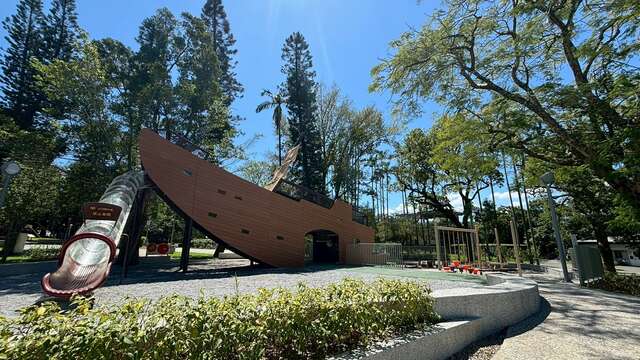Daxi Zhongzheng Park Introduction
Take a trip to Daxi Zhongzheng Park and appreciate the charm of old times. Established in 1909, "Daxi Street" was an important outpost for the Japanese colonial government, and thus urban planning was based on the concept of a "standard city," leading to the birth of Daxi's first park—Daxi Kezakan Park. Overlooking the park, shaped like Taiwan, it embodies the national belief that was unwilling to be lost amidst the assimilation movement. In 1975, the park was renamed "Zhongzheng Park" in honor of Chiang Kai-shek's contributions during his time in Taiwan. The park features three major squares: the "Sailing Boat Square," ideal for viewing the majestic landscape of Daxi Bridge crossing the Dahan Creek from a high vantage point. The "Statue Square" highlights Chiang Kai-shek on horseback, radiating the spirit of the Northern Expedition and resistance against Japan. In the center of the park stands the "Daxi Sumo Ring," featuring a traditional wooden pavilion from the Tang Dynasty. The quaint architectural style was conceived by local carpenters, with solid cypress wood beams and columns constructed without any steel nails, showcasing the exquisite craftsmanship of Daxi's wood art. The sleekly designed roof is layered with black copper tiles, exuding a nostalgic Japanese ambiance along with the fragrant aroma of cypress wood, evoking the grand sumo events of the past. The Daxi Shrine, the first shrine established in all of Taoyuan, is hidden within Zhongzheng Park; without the guidance of the five stone lanterns along the recently constructed worship path by the district office, one might easily miss it. Originally, the shrine had a worship hall and a main shrine, which were demolished after the restoration of Taiwan, leaving only the base that was transformed into the "Superb Pavilion." The stone benches and tables in the park are remnants of the former shrine, with faint inscriptions of "Showa" and "Donated." In 1975, an additional floor was added to create "Hanguang Building," offering views of the stunning Kanchin scenery. The "Fuxing Pavilion" in the park is another site from the Japanese colonial period; in 1930, many Japanese military police lost their lives while suppressing the Atayal people, prompting the establishment of a "Loyalty Monument" by Hsinchu Prefecture, which was later demolished, leading to the reconstruction of a Chinese-style pavilion on its base. The woodcraft culture is closely related to Daxi's local life, and the top is a common wooden toy; visitors to Daxi Zhongzheng Park can see a top-shaped landmark at the entrance of Puji Road Park, and sometimes spot children playing with tops in the park, inviting much amusement. Daxi Zhongzheng Park is rich in natural scenery, with an ecological pond featuring Taiwan's water ferns and wild ginger flowers, as well as various tree species including camphor, banyan, jujube, sweet gum, eggplant, black pine, osmanthus, and bald cypress, making it a resting spot filled with historical, cultural, and ecological beauty, where one can leisurely gather stories of time. The park also features a children's playground designed with the theme of "Kanchin Return of the Sails," inspired by Daxi's historical river transportation culture. The large ship area is suitable for children aged 5-12, and the small ship area caters to children aged 2-12, incorporating local stories into the design of the play equipment, blending imagination and exploration fun for children to learn and grow through play. For a different perspective of the old Daxi city, taking the 16-meter high scenic elevator for a view of the terrace scenery of the Dahan Creek is a great option. It allows you to enjoy the expansive riverside view without having to walk up steep stone steps, easily accessible in just ten seconds. For travelers who enjoy walking while savoring the scenery along the way, the cliffside trail should be on your checklist; the friendly 450-meter pathway extends from the Sailing Boat Square to the Zhenan Temple Square, allowing you to immerse in the surrounding greenery and also enjoy the beautiful sunset and the sound of flowing water from the Eight Scenic Views of Daxi.

































